Para Blog by Tiago Forte
Based on
- Intro - https://fortelabs.co/blog/para
- Operations Manual - https://fortelabs.co/blog/p-a-r-a-ii-operations-manual/
- Building a random idea generator - https://fortelabs.co/blog/p-a-r-a-iii-building-an-idea-generator/
- Setup Guide - https://fortelabs.co/blog/para-setup-guide/
- Exercise Project List Mindsweep - https://fortelabs.co/blog/p-a-r-a-v-the-project-list-mindsweep/
- Small batch projects - https://fortelabs.co/blog/p-a-r-a-part-vi-small-batch-projects-for-focus-creativity-and-perspective/
- Creating a project network - https://fortelabs.co/blog/p-a-r-a-part-vii-creating-a-project-network/
- Core principles - https://fortelabs.co/blog/p-a-r-a-viii-core-principles/
Attribution
Thanks to Tiago Forte for the inspiration with your Building a 2nd brain movement and your rich set of description, your amazing book and all your love and efforts you put into this topic.
PARA in a nutshell
A perfect organizational system
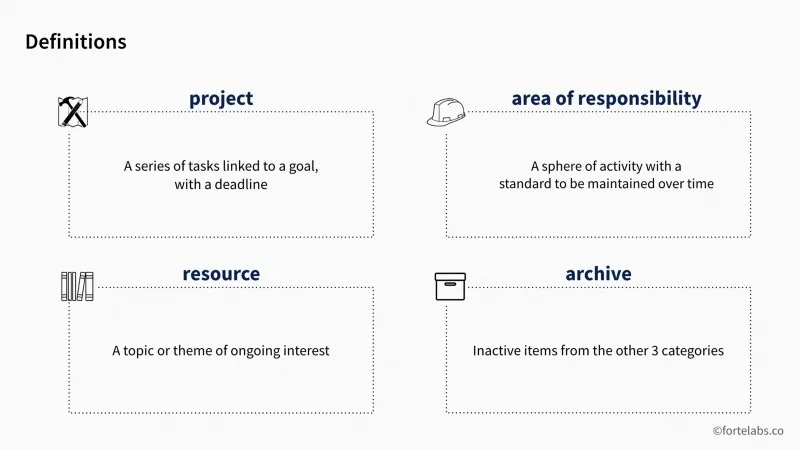
Project
Any outcome you’re committed to that requires more than one work session to complete.
A project has a goal to be achieved — a discrete event that will happen, allowing this item to be completely checked off and struck from the list. And this goal is supposed to take place by a specific moment in time. It has a deadline or timeframe, whether externally or self-imposed.
A project without a corresponding goal is known as a “hobby.” If you’re not committed to or haven’t fully articulated the outcome you want, you must be doing it just for fun.
Instead of fighting the tide and looking for “one platform to rule them all,” formulate your Project List and then replicate that list across every single tool you use, now and in the future. I recommend doing so down to the exact same spelling, punctuation, and capitalization, so that your transitions between programs are as seamless as possible.
Creating an accurate Project List gives you the confidence to say yes OR no to new commitments. Once you know how much capacity you actually have, the decision of what to fill it with can be intentional and strategic, instead of reactive.
Use the [[PARA Part 5_ The Project List Mindsweep - Forte Labs.pdf]] exercise to create the project list.
Meta Data for the Project
What is my What is a desired outcome? for this project? What would need to happen for this project to be considered an outstanding success?
Phrase desired outcomes in the present tense, to help project yourself forward in time to when the outcome you are describing has come true:
- Project: Schedule doctor’s appointment => Outcome: Back pain is resolved and I can sleep through the night without discomfort
- Project: Plan team off-site agenda => Outcome: Team is clear about what needs to be accomplished and next actions are identified and assigned
- Project: Develop sales campaign with Linda => Outcome: Sales campaign is approved by exec team, budget is allocated, and team is briefed on it
Project curation
- Look over the whole list from a bird’s eye view: does it accurately represent your current priorities, interests, values, and long-term goals?
- In which area do you have too many projects?
- Not enough?
- Which outcomes or goals you say are important to you don’t have any projects targeted at them?
- Where are you spending time or attention that has no clear outcome or goal?
- For any that are simply unclear, take a step back and ask “What am I really trying to accomplish here?” or “What bigger goal is this connected to?”
Area of responsibility
Examples include: Health; Finances, Professional Development; Travel; Hobbies; Friends; Apartment; Car; Productivity; Direct reports; Product Development; Writing
Can be spheres of activity you are responsible for in your job.
The standard continues indefinitely and requires a certain level of attention at all times.
Areas, on the other hand, require mindfulness, balance, flow, and human connection. This is the realm of habits, routines, rituals, and intentional communities. Areas require introspection and self-awareness, because determining whether or not you are meeting your standard is an intuitive exercise, not an analytical one
Areas of Responsibility are the roles you take on in life and the hats you wear (Spouse, Mother/Father, Team Leader, Soccer Coach), the ongoing standards where the buck stops with you (Product Development, Company Newsletter, Legal), and things that take a certain amount of constant attention (Exercise, Finances, Apartment, Pets).
Areas vs projects
- Running a marathon is a project, whereas Health is an area
- Publishing a book is a project, whereas Writing is an area
- Saving 3 months’ worth of expenses is a project, whereas Finances is an area
- A vacation to Thailand is a project, whereas Travel is an area
- Planning an anniversary dinner is a project, whereas Spouse is an area
If one does not separate that clearly:
- you can’t truly know the extent of your commitments
- you can’t connect your current efforts to your long-term goals
- you can’t know if you’re making progress toward your goals
By breaking these responsibilities into bite-sized projects (as in the list on the right), you ensure that your Project List will change nearly every week. This creates a rhythm and a momentum of project completion to maintain your motivation. It generates the constant novelty that the latest research suggests is essential for satisfaction.
Are you currently meeting the standard you’ve set for yourself in each of the areas you’re committed to? If not, are there any new projects, habits, routines, rituals, or other practices you’d like to start, stop, or change?
importance of separating the very small amount of actionable information from the much larger amount of non-actionable information
It’s much more important, in my opinion, to associate projects with their respective goals, rather than areas.
Areas vs Resources
There is a very clear line between things that you are responsible for, and those that you’re merely interested in.
(Mental notes: So this means that having my Agile Area makes sense as I’m also responsible for it)
put personally relevant information in Areas, and generally useful information in Resources
Example for Resources To Areas: This flow would occur if you realized a piece of information in a resource notebook could apply to an area of responsibility in your life. Maybe you have a Recipes (resource) notebook, and realize that one of the recipes in it could come in handy for a new standard you’ve committed to, such as cooking healthier meals for your family (an area).
Resource
a topic or theme of ongoing interest.
Resources are interests (web design, crowdfunding, woodworking, frisbee golf, bio-hacking), themes (psychology, politics, leadership, integrity), and assets (stock photos, typography links, marketing swipe file, product testimonials, code snippets). I even use lower-case titles with resource notebooks, to remind myself that they are just interests, and capital letters for areas of responsibility.
Examples include: habit formation; project management; transhumanism; coffee; music; gardening; online marketing; SEO; interior design; architecture; note-taking
Are there any new interests you’d like to pursue more seriously?
The Resources stack is also where “research” lives. The notebooks here tend to have the most objectively valuable information, which you may want to access when looking for material to use in a blog post, to recommend to someone, or for a work project.
In a project it doesn’t make sense to have to drill down through a bunch of non-actionable information in order to find the actionable stuff.
Archives
WHAT KINDS OF THINGS SHOULD I SAVE?
You are looking for insightful, high-value, ambiguous yet impactful information that you will be able to revisit, connect, and combine together to stimulate future thinking.
Here are some good questions to ask yourself when considering whether to save something:
- Is this something that could inspire or help me if it surfaced at some point in the future?
- Is this potentially a useful source, building block, or tool for future projects?
- Is this unique, personal, or hard-won knowledge worth revisiting over time?
- Is this something that I’m unlikely to find in the future when I need it?
Examples
- Book notes
- Excerpts from online articles
- Quotes
- Notes from audiobooks or podcasts
- Screenshots and web bookmarks
- Voice memos
- Photos, graphics, and diagrams
- PDFs
- Outlines and summaries
- Notes from conferences or events
- Interviews or FAQs
- Templates & checklists
- Notes from webinars or online courses
- Brainstorms & mindmaps
- Slide presentations
- Notebook sketches
- Journal or diary entries
- Marketing/business ideas
- Email newsletters
- Travel ideas and plans
- Notes from classes or workshops
- Reading list (or Already Read list)
- Meeting notes and recordings
- Project planning notes
- Work samples and portfolio
- Goals and dreams
- Productivity/health tips
- User manuals/guides
- Writing ideas/prompts
Principles
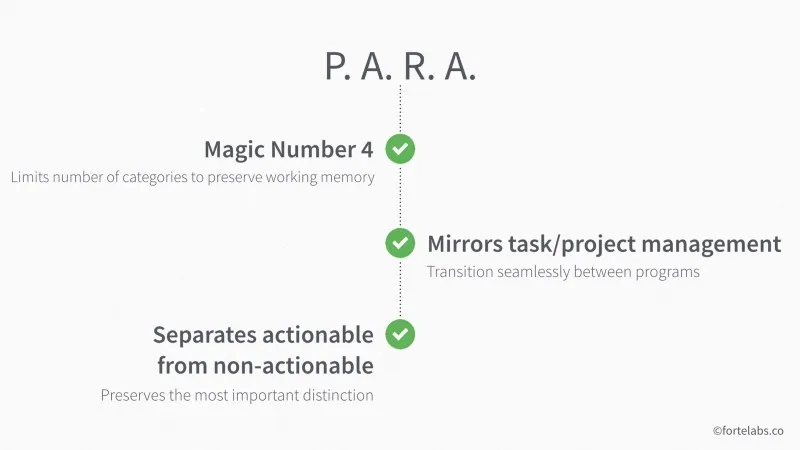
The first principle is that it uses the magic number 4 as a guidepost. The entire hierarchy is four categories wide (projects, areas, resources, archives), and no more than four levels deep (using Evernote as an example, the levels would be: application > stacks > notebooks > notes).
- the magic number 4 as a guidepost
- mirrors your task management and project management systems
- distinction between actionable and non-actionable information
Core Principles
- Organize by actionability
- Organize opportunistically
- Move quickly, touch lightly
- Controlled randomness
- Complex systems have to be grown, not made
- Focus on outcomes
- Fail gracefully
- Shallow hierarchies
Organize by actionability
see [[#Horizons of Actionability]]
Organize opportunistically
P.A.R.A. is designed to be bottom-up, avoiding expensive heavy lifts at all costs. This is to avoid doing upfront work of questionable value, to avoid sunk costs, and to remain as open as possible to changes in direction.
Move quickly, touch lightly
This keeps the investment in any given action low, nudging our organizational systems in a certain direction while avoiding total commitment.
Controlled randomness
P.A.R.A. demands precision in only one very specific place: the definition of projects. Everywhere else, fuzziness is not only allowed but encouraged. It recognizes that imposing order on information doesn’t always make it more valuable. The greatest breakthroughs are usually found in bizarre, unexpected, or counterintuitive connections. This requires a system that allows diverse ideas to mix together.
Complex systems have to be grown, not made
Gall’s Law, which states that “all complex systems that work evolved from simpler systems that worked.”
Complex systems have to be grown slowly over time, because their interdependencies and variables are too complex to guess correctly the first time.
This is why I avoid showing too much of my own system – it has grown to a certain level of sophistication over years. Going straight to this level of maturity would be counterproductive for any novice. (this is also highly relevant for the introduction of agile)
Focus on outcomes
Everything in P.A.R.A. is subordinated to the outcome of getting things done.
- tying up tasks in a state that is easy to pick up again
- scheduling complex tasks and fitting others around them
- communicating progress to everyone who is depending on it
- always unblocking what is keeping you or others from moving forward
Fail gracefully
But in fact it can be seen as a strength: because P.A.R.A. is neither centralized nor decentralized, but federated, it doesn’t need to be perfectly maintained like a well-oiled machine. I’ve found that the folders can drift apart for months with no real impact on my productivity.
Shallow hierarchies
Instead of getting shuffled to ever greater depths, where we lose sight of them, files are shuffled from actionable notebooks into the Archives.
How things are connected
We spend our days completing tasks, which are grouped naturally into projects, which fall under areas of responsibility.
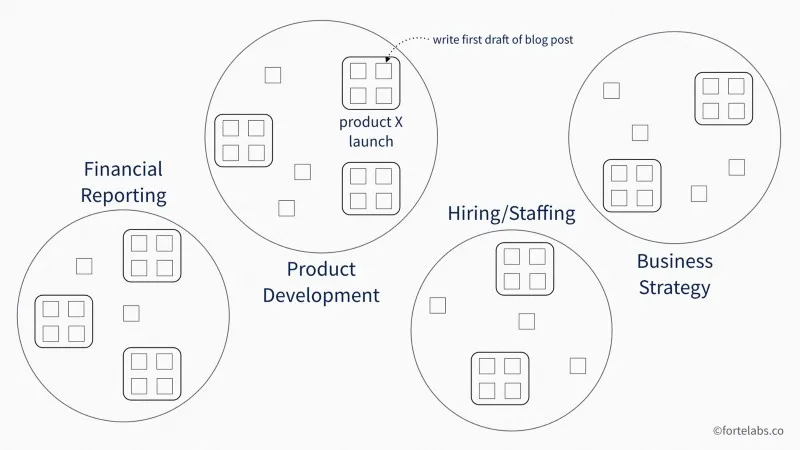
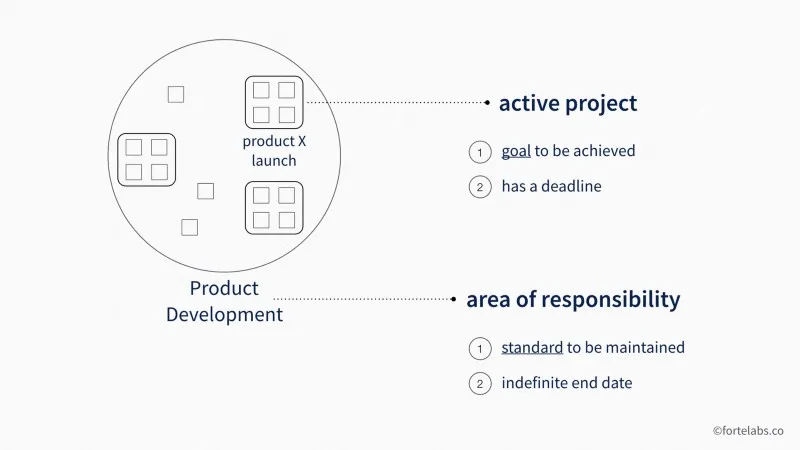
Horizons of Actionability
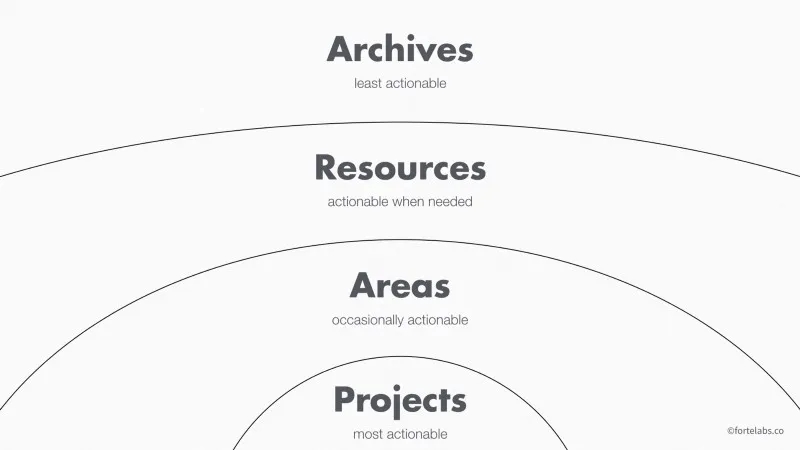
Working with Small-Batch projects
But information overload is not a feature of the external world. It’s not even a feature of how much information you consume. It is a function of how much you allow to occupy your attention at any given moment. By narrowing your attention to only one actionable stack most of the time, you allow the other stacks to grow exponentially larger with no impact on your attention.
The ability to accelerate project turnover simply by reducing the size of projects gives you the ability to produce novelty on demand, for even the most boring administrative tasks. If I encounter a project I’m resistant to, I simply keep making it smaller until the reward feels more tangible than the pain. This gives me control of the drumbeat of fulfilled deadlines, which I tune to maximize my sense of self-efficacy.
Networks of projects
Projected form a network with interfaces defined by What is a desired outcome? Theory of Constraints calls this a Prerequisite Tree or a Necessary Condition Network
Your projects are the nodes in your personal productivity network. They are the containers into which information flows, intelligence is applied, and work is performed. Desired outcomes are the interfaces between these nodes, allowing projects to work together and become more than the sum of their parts.
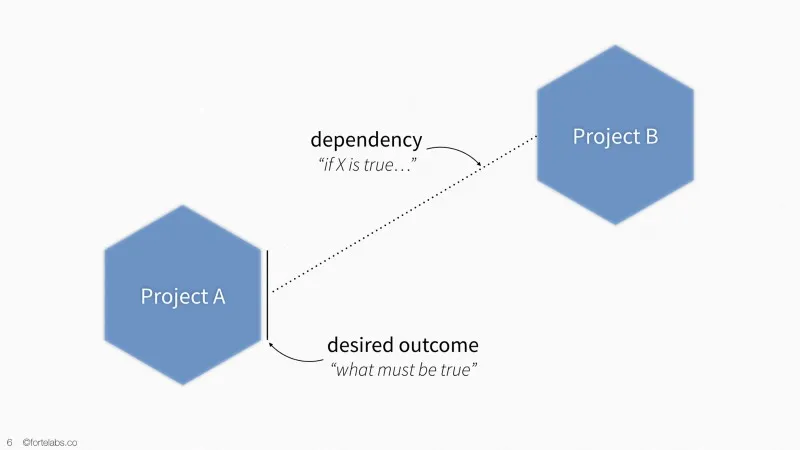
If it’s unclear where a project begins and ends, it’s like an irregularly shaped, fuzzy node. Like Legos, not having a clean edge means it can never become a piece in a beautiful new creation.
Recommended Sources
[[Antifragile]] [[Seeing Like a State ]] [[Incomplete Nature]] [[Satisfaction -The Science of Finding True Fulfillment notes]] The Power of Habit
Linking
- PARA Method Notes (later integrate both notes)
- MOC Building a 2nd brain